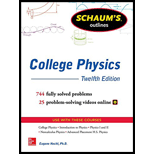
Concept explainers
Two long fixed parallel wires, A and B, are 10 cm apart in air and carry 40 A and 20 A, respectively, in opposite directions. Determine the resultant field (a) on a line midway between the wires and parallel to them and (b) on a line 8.0 cm from wire A and 18 cm from wire B. (c) What is the force per meter on a third long wire, midway between A and B and in their plane, when it carries a current of 5.0 A in the same direction as the current in A?
(a)
The magnetic field at the line midway between the parallel wires
Answer to Problem 25SP
Solution:
Explanation of Solution
Given data:
The distance between the wires
The current flowing in wire
The current flowing in wire
The direction of current in the wires is opposite to each other.
Formula used:
The expression for the magnetic field due to the long straight wire is written as
Here,
The right-hand thumb rule states that if the thumb shows the direction of the current, then the curled fingers show the direction of the magnetic field. Pictorially, this is expressed as
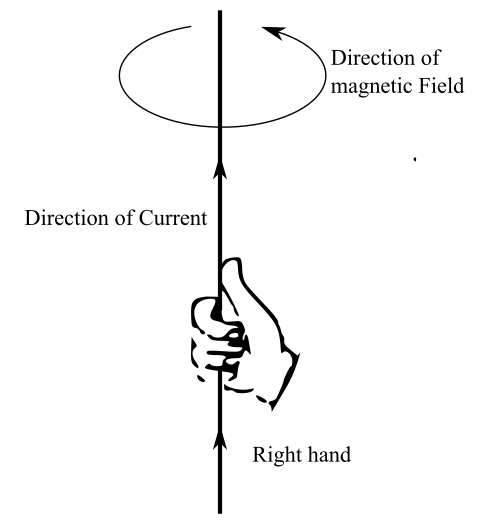
Explanation:
Draw the diagram according to the problem:
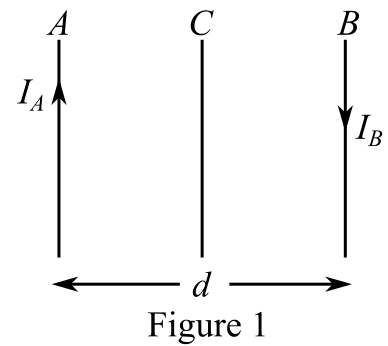
Here,
Now, write the expression for magnetic field around wire
Here,
Substitute
Understand that wire
Substitute
The direction of the magnetic field around wire
Write the expression for magnetic field around wire
Here,
Substitute
Understand that wire
Substitute
The direction of the magnetic field around wire
Write the expression for the total magnetic field aroundwire
Substitute
Understand that the direction of the magnetic field at wire
Conclusion:
Hence, the magnetic field around the line midway between the parallel wires
(b)
The magnetic field ona line
Answer to Problem 25SP
Solution:
Explanation of Solution
Given data:
The current flowing in wire
The current flowing in wire
The line is
The line is
The direction of current in the wires is opposite to each other.
Formula used:
The expression for the magnetic field due to the long straight wire is written as
Here,
The right-hand thumb rule states that if the thumb shows the direction of the current, then the curled fingers show the direction of the magnetic field. Pictorially, this is expressed as

Explanation:
Draw the diagram according to the problem:
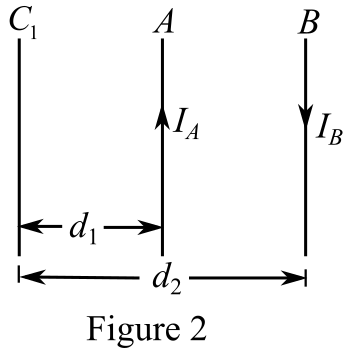
Here, wire
Now, write the expression for the magnetic field at wire
Substitute
The direction of the magnetic field around wire
Write the expression for the magnetic field around wire
Substitute
The direction of the magnetic field around wire
Write the expression for the total magnetic field aroundwire
Substitute
Understand that the direction of the magnetic field around wire
Conclusion:
Hence, the magnetic field around a line between the wires
(c)
The force per meter on the third wire midway between wires
Answer to Problem 25SP
Solution:
Explanation of Solution
Given data:
The current flowing in wire
The current flowing in wire
The direction of current in the wires is opposite to each other.
The current in third wire is
Formula used:
The expression for the force acting on a wire due to magnetic field is written as
Here,
Explanation:
Draw the diagram according to the problem:
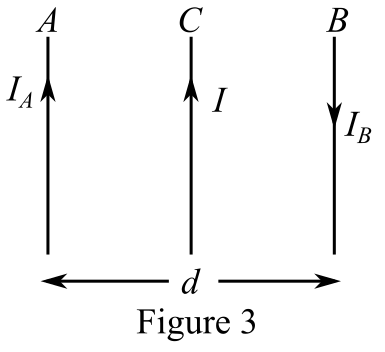
Recall the expression for the force acting on a wire due to magnetic field:
Rearrange the expression for
Recall the value of the calculated magnetic field from subpart (a) and substitute
Using the right-hand rule, wire
Conclusion:
Hence, the force per meter on the third wire midway between wire
Want to see more full solutions like this?
Chapter 31 Solutions
Schaum's Outline of College Physics, Twelfth Edition (Schaum's Outlines)
- Solve and answer the question correctly please. Thank you!!arrow_forward་ The position of a particle is described by r = (300e 0.5t) mm and 0 = (0.3t²) rad, where t is in seconds. Part A Determine the magnitude of the particle's velocity at the instant t = 1.5 s. Express your answer to three significant figures and include the appropriate units. v = Value Submit Request Answer Part B ? Units Determine the magnitude of the particle's acceleration at the instant t = 1.5 s. Express your answer to three significant figures and include the appropriate units. a = Value A ? Unitsarrow_forwardSolve and answer the question correctly please. Thank you!!arrow_forward
- Solve and answer the question correctly please. Thank you!!arrow_forwardA spiral transition curve is used on railroads to connect a straight portion of the track with a curved portion. (Figure 1) Part A v = v₁ft/s 600 ft y = (106) x³ If the spiral is defined by the equation y = (106)³, where x and y are in feet, determine the magnitude of the acceleration of a train engine moving with a constant speed of v₁ = 30 ft/s when it is at point x = 600 ft. Express your answer to three significant figures and include the appropriate units. ? a = Value Unitsarrow_forwardsolve and answer the problem correctly please. Thank you!!arrow_forward
- Solve and answer the question correctly please. Thank you!!arrow_forwardSolve and answer the question correctly please. Thank you!!arrow_forwardWhen the motorcyclist is at A, he increases his speed along the vertical circular path at the rate of = (0.3t) ft/s², where t is in seconds. Take p = 360 ft. (Figure 1) Part A 60° Ρ B If he starts from rest at A, determine the magnitude of his velocity when he reaches B. Express your answer to three significant figures and include the appropriate units. v = Value Submit Request Answer ་ Part B ? Units If he starts from rest at A, determine the magnitude of his acceleration when he reaches B. Express your answer to three significant figures and include the appropriate units. 11 ? a = Value Unitsarrow_forward
- The car starts from rest at s = 0 and increases its speed at a₁ = 7 m/s². (Figure 1) Part A = 40 m Determine the time when the magnitude of acceleration becomes 20 m/s². Express your answer to three significant figures and include the appropriate units. ? t = Value Units Part B At what position s does this occur? Express your answer to three significant figures and include the appropriate units. s = Value Submit Request Answer ? Unitsarrow_forwardSolve and answer the question correctly please. Thank you!!arrow_forwardSolve and answer the question correctly please. Thank you!!arrow_forward

 Glencoe Physics: Principles and Problems, Student...PhysicsISBN:9780078807213Author:Paul W. ZitzewitzPublisher:Glencoe/McGraw-Hill
Glencoe Physics: Principles and Problems, Student...PhysicsISBN:9780078807213Author:Paul W. ZitzewitzPublisher:Glencoe/McGraw-Hill Physics for Scientists and Engineers: Foundations...PhysicsISBN:9781133939146Author:Katz, Debora M.Publisher:Cengage Learning
Physics for Scientists and Engineers: Foundations...PhysicsISBN:9781133939146Author:Katz, Debora M.Publisher:Cengage Learning Principles of Physics: A Calculus-Based TextPhysicsISBN:9781133104261Author:Raymond A. Serway, John W. JewettPublisher:Cengage Learning
Principles of Physics: A Calculus-Based TextPhysicsISBN:9781133104261Author:Raymond A. Serway, John W. JewettPublisher:Cengage Learning College PhysicsPhysicsISBN:9781305952300Author:Raymond A. Serway, Chris VuillePublisher:Cengage Learning
College PhysicsPhysicsISBN:9781305952300Author:Raymond A. Serway, Chris VuillePublisher:Cengage Learning College PhysicsPhysicsISBN:9781285737027Author:Raymond A. Serway, Chris VuillePublisher:Cengage Learning
College PhysicsPhysicsISBN:9781285737027Author:Raymond A. Serway, Chris VuillePublisher:Cengage Learning





